Self-Diagnosis in Autism
Exploring Autistic Identity and the Role of Self-Assessment

Understanding Self-Diagnosis in Autism Spectrum Disorder
The rise of self-diagnosis within the autism community reflects broader societal shifts towards acceptance, understanding, and accessibility. As more adults and caregivers turn to online resources and personal research, questions naturally arise about the validity, processes, and implications of self-identifying as autistic. While a formal diagnosis remains the gold standard for accessing services and legal protections, self-diagnosis plays a significant role in shaping personal identities and community connections. This article delves into the nuances of self-diagnosis, examines current research, and provides guidance on steps to take following self-recognition of autistic traits.
Understanding Autism Spectrum Disorder (ASD) and Its Characteristics
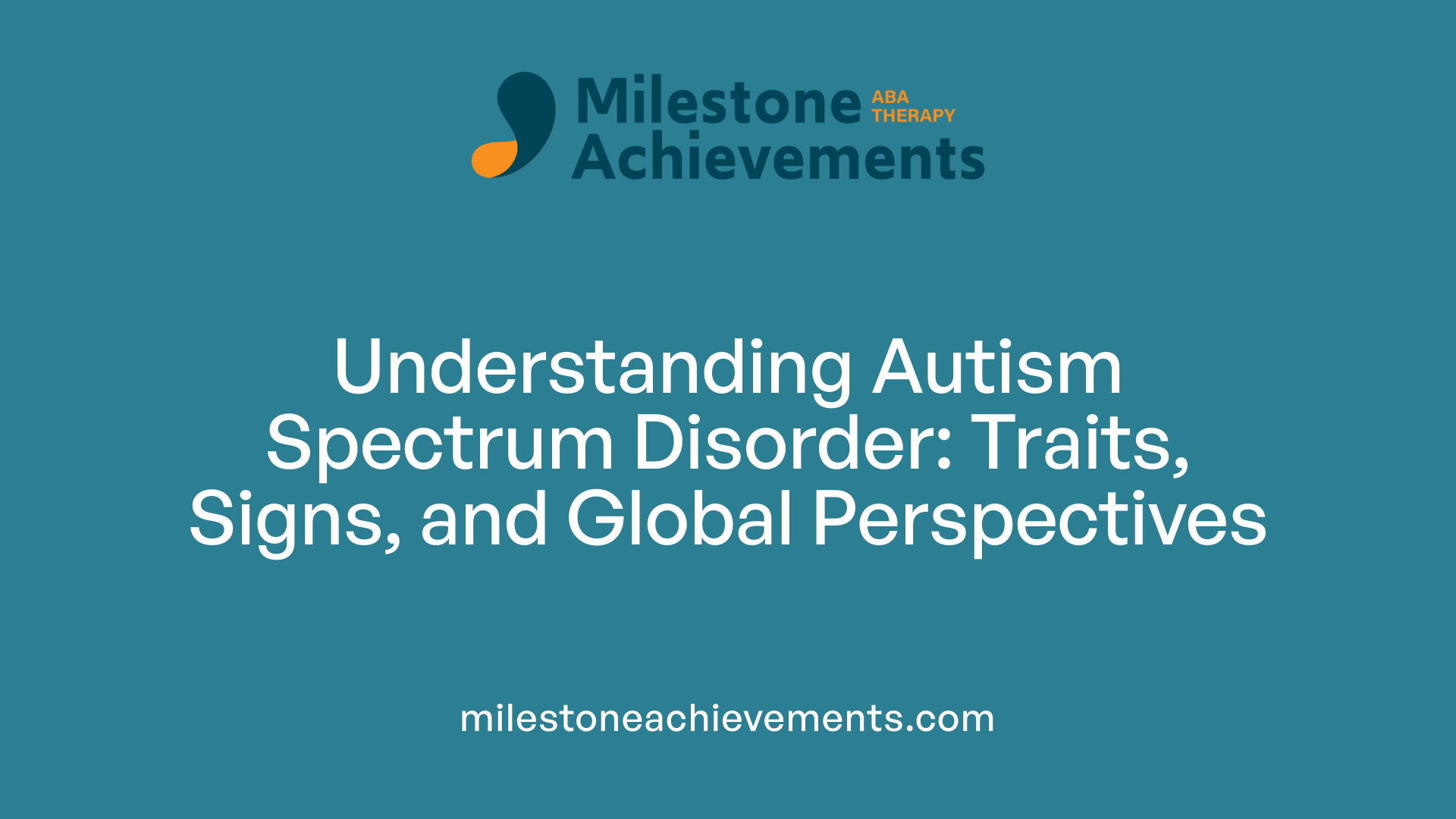
What is autism spectrum disorder (ASD)?
Autism spectrum disorder (ASD) is a neurological and developmental condition characterized by difficulties in social interaction, communication, learning, and behavior. Typically appearing within the first two years of life, ASD presents with a wide range of symptoms and severity, which is why it is referred to as a spectrum. Individuals with ASD may experience ongoing social challenges, repetitive behaviors, and focused interests that can significantly affect their daily lives and functioning across social, academic, or occupational settings.
What are the typical symptoms of ASD?
People with ASD often display several common traits that can vary from person to person.
- Social Difficulties: Challenges in forming and maintaining friendships, understanding social cues, and sharing interests.
- Communication Problems: Difficulties with both verbal and non-verbal communication, such as delayed language development or trouble interpreting body language.
- Repetitive Behaviors: Engaging in routines, lining up objects, and repetitive motions.
- Limited or Intense Interests: Focused interests that are narrow but deeply engaging.
These characteristics can impair daily functioning and are often noticeable early in life. The severity and combination of symptoms differ, with some individuals requiring significant support while others are highly independent.
Are symptoms of ASD present from early childhood?
Yes, signs of ASD typically emerge within the first two years of life. Early indications include delayed speech, reduced response to social engagement, and sensory sensitivities such as aversion to certain sounds or textures.
However, in some cases, especially when symptoms are subtle, the diagnosis might be delayed. Recognizing early signs can lead to earlier intervention, which is crucial for supporting development.
Is ASD diagnosis consistent across cultures and populations?
While ASD is recognized worldwide, its diagnosis can be influenced by cultural and systemic factors. Studies show that ASD tends to be underdiagnosed among marginalized groups, including Black, Latinx, and non-cisgender populations, due to barriers like limited access to healthcare, cultural differences in behavior interpretation, and systemic biases.
In the United States, approximately 1 in 44 children aged eight are estimated to have ASD. Despite differences in diagnostic rates across various populations, the core features of ASD are consistent globally. Efforts continue to improve diagnostic equity and awareness across different communities, ensuring more accurate and timely identification of autism.
| Aspect | Description | Additional Notes |
|---|---|---|
| Prevalence | 1 in 44 children (U.S.) | Higher in boys, underdiagnosed in marginalized groups |
| Onset | Symptoms appear within the first two years | Early signs include speech delays and social withdrawal |
| Variability | Wide spectrum of behaviors | Ranges from requiring extensive support to high-functioning |
| Cultural Factors | Underdiagnosis in certain populations | Influenced by systemic biases and access issues |
Understanding these features and recognizing the early signs can facilitate support and connections that improve quality of life for individuals with ASD. Recognizing the variability in presentation underlines the importance of tailored approaches in diagnosis and intervention.
The Process and Challenges of Diagnosing Autism
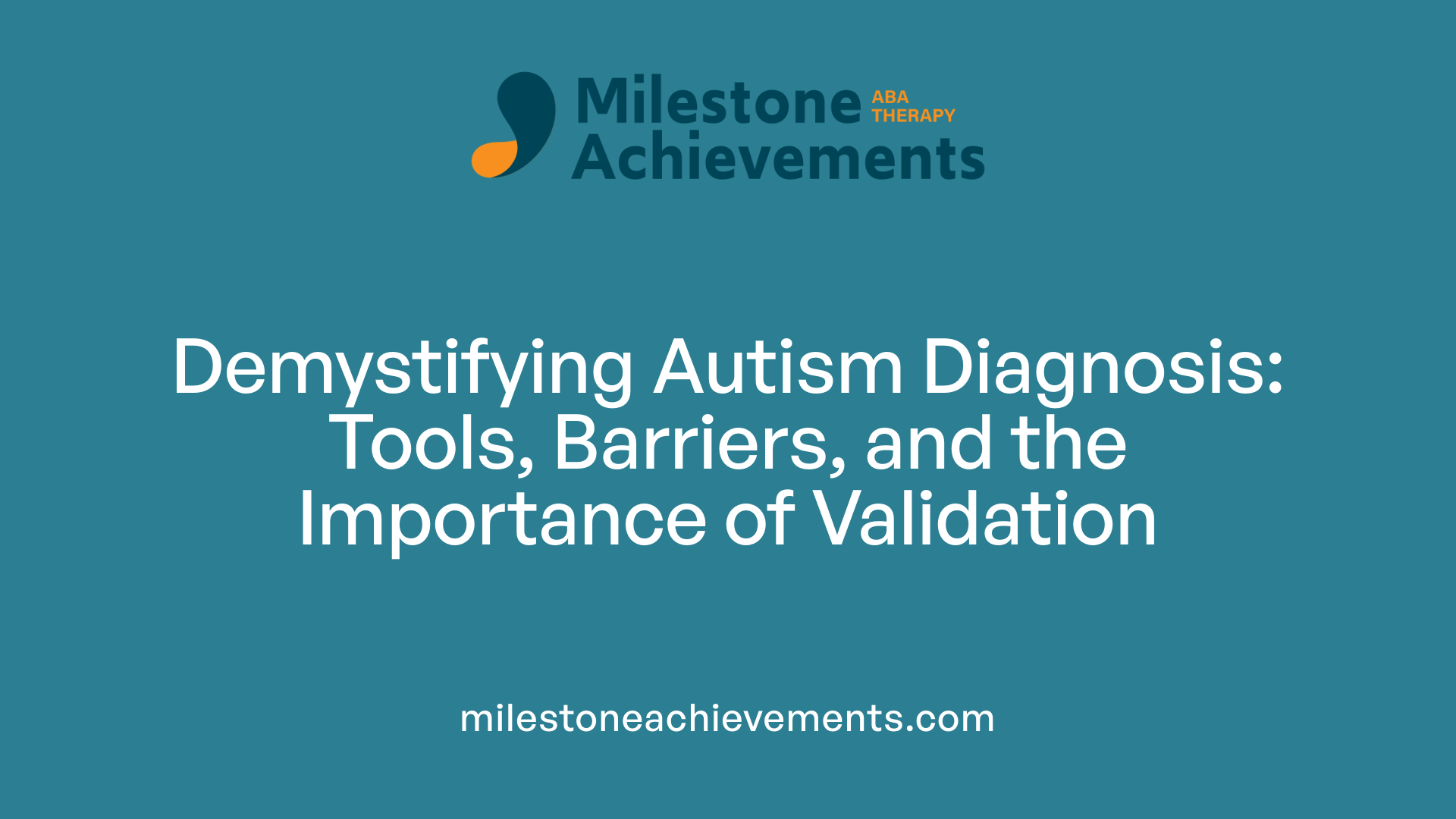
How is autism diagnosed by professionals?
Diagnosing autism is a detailed process that requires evaluation by trained health professionals, such as psychologists, neuropsychologists, or psychiatrists. They conduct thorough assessments, which include reviewing an individual's developmental history, observing behavior directly, and employing standardized tools designed to evaluate autism-related traits. These assessments follow established criteria, primarily those outlined in the DSM-5, to differentiate autism from other similar conditions and identify any co-occurring challenges.
This comprehensive approach helps ensure an accurate diagnosis, considering the wide spectrum of how autism can present, especially in adults where symptoms can be more subtle or masked.
Are there specific tools for autism screening?
Yes, various screening instruments are available to indicate the likelihood of autism across different age groups. For very young children, tools like the Modified Checklist for Autism inToddlers, Revised (M-CHAT-R), and the Social Attention and Communication Surveillance-Revised (SACS-R) are commonly used.
For older children, adolescents, and adults, screening tools such as the Autism Quotient (AQ), the Empathy and Systemizing Quotient (ESQ), and the Ritvo Autism Asperger Diagnostic Scale-Revised (RAADS-R) can help identify traits associated with autism.
These tools are valuable for initial assessment phases but do not replace formal clinical evaluations. When screening results suggest autism, a full diagnostic assessment is typically conducted to confirm the condition and plan appropriate support.
What barriers prevent adults from obtaining a formal diagnosis?
Many adults face significant challenges in accessing formal autism assessments. High costs associated with evaluations and long waiting periods are common hurdles. In addition, systemic issues such as a shortage of qualified professionals—especially in rural or underserved regions—limit access.
Some adults encounter skepticism or dismissiveness from healthcare providers, often due to stereotypes about how autism presents in adults or misconceptions about intelligence and communication skills. These factors, combined with societal stigma and personal fears of discrimination, may deter adults from seeking diagnosis.
Furthermore, systemic barriers disproportionately impact marginalized communities, including Black, Latinx, and non-cisgender individuals, who often experience underdiagnosis and less access to services due to disparities in healthcare and societal biases.
Why is diagnosis important?
Obtaining a formal diagnosis validates an individual's experiences and can open doors to essential tailored supports and interventions. It facilitates access to educational resources, healthcare services, employment accommodations, and legal protections.
Beyond practical benefits, diagnosis provides personal clarity—helping individuals understand their behaviors and needs better. It can also foster a sense of belonging within the neurodivergent community, reducing feelings of isolation.
While self-identification and community support are valuable, especially when formal diagnosis access is limited, an official diagnosis remains crucial for certain rights and services. Ultimately, diagnosis supports both personal understanding and systemic inclusion.
Self-Diagnosis: Its Validity, Benefits, and Limitations
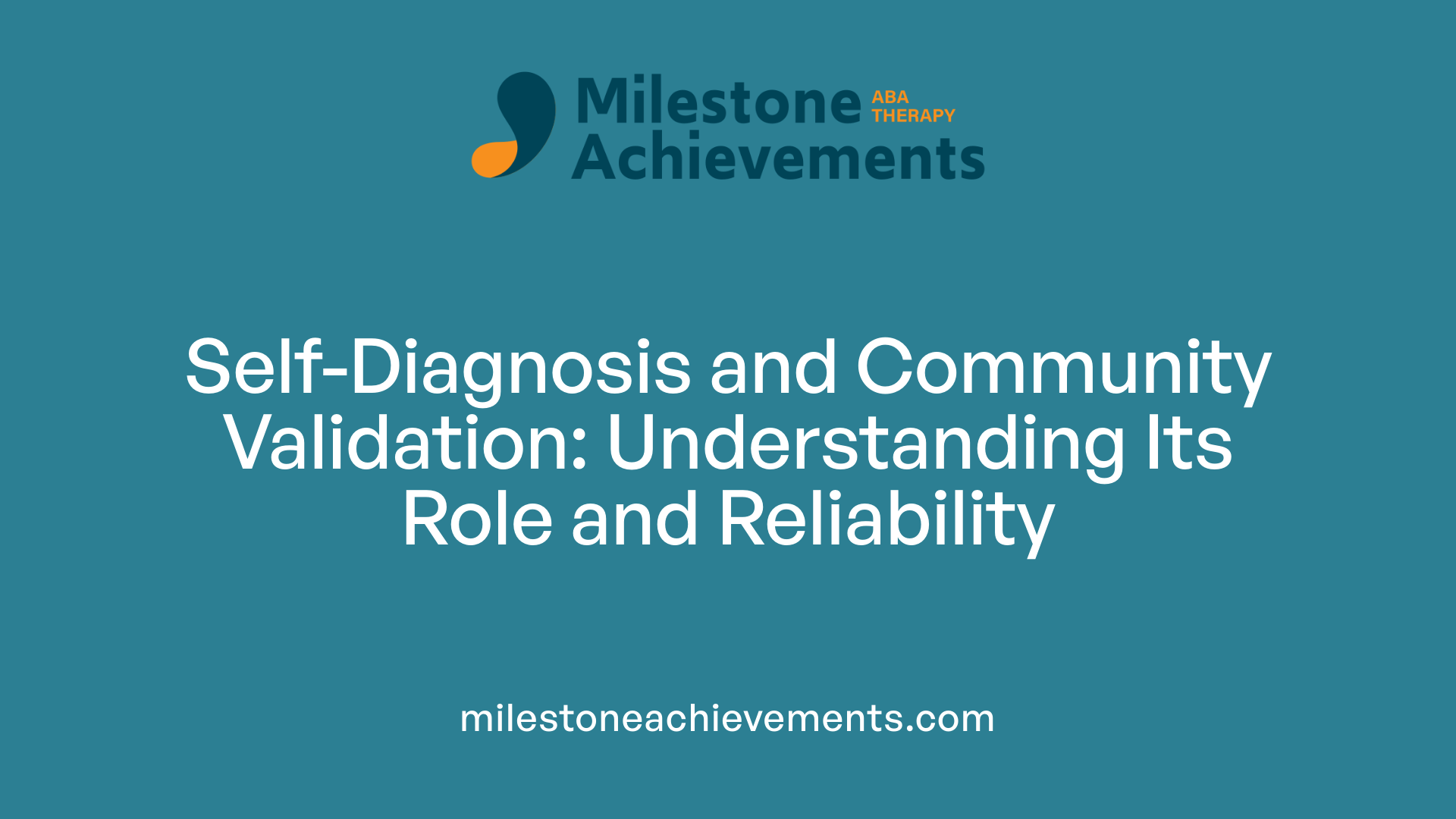
What is self-diagnosis and self-identification?
Self-diagnosis involves individuals recognizing themselves as autistic based on their personal experiences, traits, and self-conducted research. This process is often driven by feelings of difference, difficulty understanding social cues, sensory sensitivities, or behavioral patterns aligned with autism. Self-identification is a broader concept that encompasses individuals acknowledging their identity as part of the autism spectrum without necessarily having undergone formal clinical evaluation.
Many adults turn to online resources, screening tools, and community support to help determine if they might be autistic. These tools, such as the Autism Quotient (AQ) or RAADS–R, can provide indications but are not substitutes for professional diagnosis.
Community acceptance and validation
Within the autistic community, self-diagnosis is increasingly accepted and valued. About 64% of surveyed autistic individuals believe that a formal diagnosis should not be a prerequisite for identifying as autistic. Many community organizations, including Autism BC, support and validate self-diagnosis, emphasizing the importance of personal experience and community recognition.
Self-identification can foster a sense of belonging, improve self-understanding, and reduce feelings of isolation. It also enables individuals to access online support groups, advocacy, and resources—especially when traditional pathways to diagnosis are blocked by systemic barriers.
Research findings on accuracy and reliability
Recent studies suggest that self-diagnosis can be quite accurate. For instance, the RAADS–R, a self-report screening tool, has demonstrated strong predictive validity for identifying autism. Research by Sturm et al. (2024) found no significant differences between formally diagnosed and self-identified adults in measures of autism traits, stigma, and quality of life.
Self-identified adults often exhibit traits and experiences similar to those with formal diagnoses, supporting the validity of self-diagnosis. However, complexities such as overlapping conditions—like ADHD, anxiety, or trauma—can lead to misinterpretation, underscoring the importance of professional assessment when possible.
The community’s growing acceptance is backed by evidence indicating that self-diagnosis can serve as a meaningful step toward understanding oneself, especially when systemic barriers prevent timely or affordable access to clinical services.
Can you self-diagnose autism in adults?
Self-diagnosing autism in adults is a common practice within the community and can facilitate insight, validation, and community connection. Nonetheless, it must be emphasized that self-diagnosis is not a replacement for a formal diagnosis from licensed healthcare providers. Professional evaluations involve detailed developmental histories, observations, standardized assessments, and input from family or previous caregivers. While reputable self-report tools can suggest the likelihood of autism, ultimate confirmation should come from qualified clinicians.
What steps should I take after self-diagnosing autism?
After self-identification, seeking clarity through a professional assessment is advisable when accessible. The first step includes familiarizing oneself with criteria outlined in the DSM-5 and taking online screening tests like the AQ or RAADS–R for further reflection.
Engaging with support groups, reading literature, and consulting advocacy organizations can strengthen understanding and provide emotional support. When feasible, scheduling an evaluation with qualified psychologists or psychiatrists can lead to a formal diagnosis, unlocking access to specialized support, accommodations, and legal protections.
How reliable and valid is self-diagnosis?
Evidence supports the high accuracy of self-diagnosis when individuals use reputable tools and self-assessment methods. Studies, including those analyzing the RAADS–R, have shown strong predictive validity, meaning that self-reports align well with clinical assessments.
Nevertheless, there are limits. Conditions like ADHD, social anxiety, and trauma symptoms can mimic autism traits, possibly leading to misinterpretation. Despite these challenges, many self-diagnosed individuals report traits, struggles, and strengths consistent with clinical findings.
Are there risks associated with self-diagnosis?
Risks include misinterpreting symptoms, over-diagnosing oneself, or missing other co-occurring conditions that require different treatments. Without professional validation, there is also a chance of misinformation, over-pathologizing normal variations, or; in some cases, missing out on critical supports, especially for comorbid conditions.
Therefore, while self-diagnosis can be empowering and meaningful, it should ideally be viewed as a first step or complement to professional evaluation, not a definitive conclusion.
| Aspect | Details | Additional Notes |
|---|---|---|
| Recognition | Growing acceptance in community | Supports personal identity and belonging |
| Accuracy | High when based on reputable tools | Overlap with other conditions can complicate self-view |
| Risks | Misinterpretation, missing treatments | Should pursue professional assessment when possible |
| Benefits | Self-understanding, validation, support access | Useful when barriers to diagnosis exist |
In summary, self-diagnosing autism in adults is increasingly recognized as valid within communities and supported by research, but it is most effective when complemented by professional assessment. Supports and validation from community organizations enrich the process, promoting well-being and informed self-awareness.
Impacts of Self-Identification on Personal and Community Wellbeing
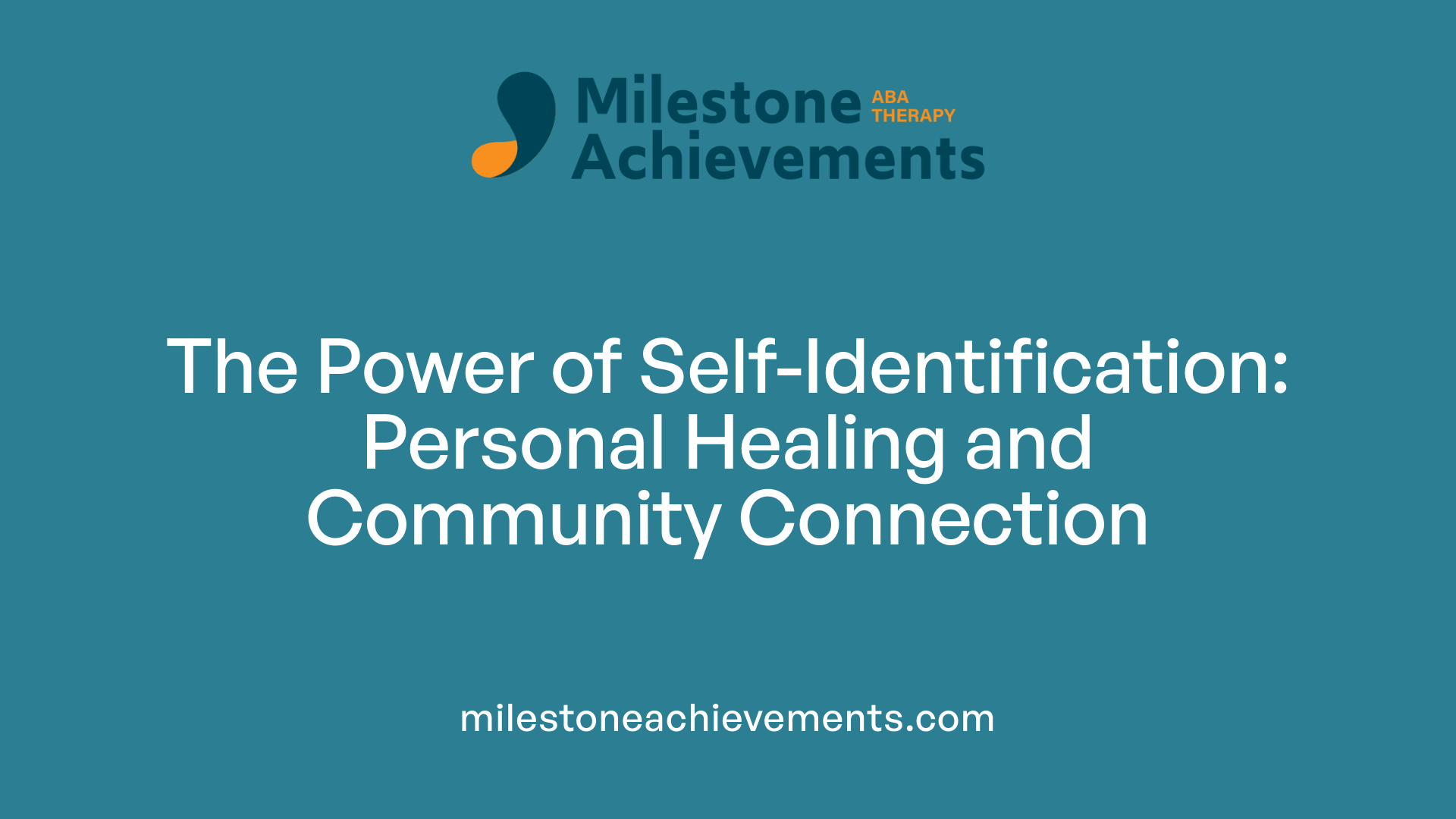
What emotional or social benefits can come from self-diagnosing or self-identifying as autistic?
Self-diagnosis and self-identification can have profound effects on an individual's emotional and social wellbeing. Many autistic adults report feeling a sense of relief upon recognizing traits they have experienced all their lives. This recognition can validate their personal experiences, reducing feelings of confusion or self-doubt.
Moreover, self-identifying as autistic often leads to a stronger sense of belonging within the autistic community. Online communities and support groups provide spaces for sharing stories, exchanging resources, and fostering mutual understanding. These platforms help individuals feel accepted and understood, which can be particularly empowering for those facing societal stigma or systemic barriers to formal diagnosis.
Understanding oneself better through self-identification can also boost self-acceptance and mental wellbeing. It offers a way to embrace neurodivergence as a part of personal identity, encouraging confidence and resilience. Additionally, access to online resources and information allows individuals to explore their traits further, learn coping strategies, and connect with others who share similar experiences.
How do the autistic community and professionals view self-diagnosis?
Within the autistic community, there is broad support for self-diagnosis. Many advocacy groups, including Autism BC, acknowledge that self-diagnosis can be a valid and meaningful step, especially where systemic barriers prevent access to formal assessments. Community members often emphasize that self-identification fosters self-understanding, validation, and community belonging.
However, the perspective among professionals and some critics is more cautious. Concerns exist about the potential for misdiagnosis, especially when overlapping conditions such as ADHD, social anxiety, or trauma-related issues mimic autistic traits. They stress the importance of clinical validation to ensure appropriate support and to avoid resource misallocation.
Despite these concerns, many experts recognize the importance of respecting individuals’ self-awareness and their right to identify as autistic. Some suggest that a balanced approach—supporting self-identification while encouraging formal assessment when possible—is most beneficial.
What are the societal implications of increased self-identification?
The rising trend of self-identification reflects deeper systemic issues within healthcare and society. High costs, long waiting times, and limited access to qualified professionals create barriers that prevent many from obtaining a formal diagnosis. This situation has resulted in a greater reliance on self-assessment and community support.
Societally, increased self-identification promotes greater visibility and acceptance of neurodiversity, challenging stereotypes and fostering inclusivity. Recognizing self-diagnosis as a legitimate experience helps normalize neurodivergence, encouraging workplaces, educational institutions, and social services to adapt supportive measures.
However, there are challenges as well. Ensuring that resources are allocated fairly and supports are appropriately tailored remains a concern. Healthcare systems need to develop inclusive pathways that recognize self-identification while maintaining diagnostic rigor.
Overall, acknowledging self-diagnosis can drive social change towards a more inclusive society that values diverse ways of thinking, learning, and experiencing the world.
| Aspect | Community Perspective | Professional View | Societal Impact |
|---|---|---|---|
| Acceptance of Self-Diagnosis | Generally positive; seen as valid and empowering | Cautiously supportive; emphasizes need for validation | Promotes visibility, reduces stigma, encourages inclusivity |
| Concerns | Risk of misdiagnosis, overlapping conditions | Diagnostic accuracy, resource allocation | Challenges in support systems, need for equitable healthcare |
| Benefits | Self-understanding, community belonging, validation | Appropriate support, clinical validation | Increased societal awareness of neurodiversity |
Supporting the growing number of self-identified individuals, community organizations like Autism BC advocate for greater understanding and acceptance of self-diagnosis, emphasizing its positive role in personal recovery and community cohesion. As research continues and diagnostic practices evolve, a balanced approach respecting both personal experience and clinical expertise can foster a more inclusive and supportive environment for all.
Legal and Practical Resources for Self-Identified Autistic Individuals
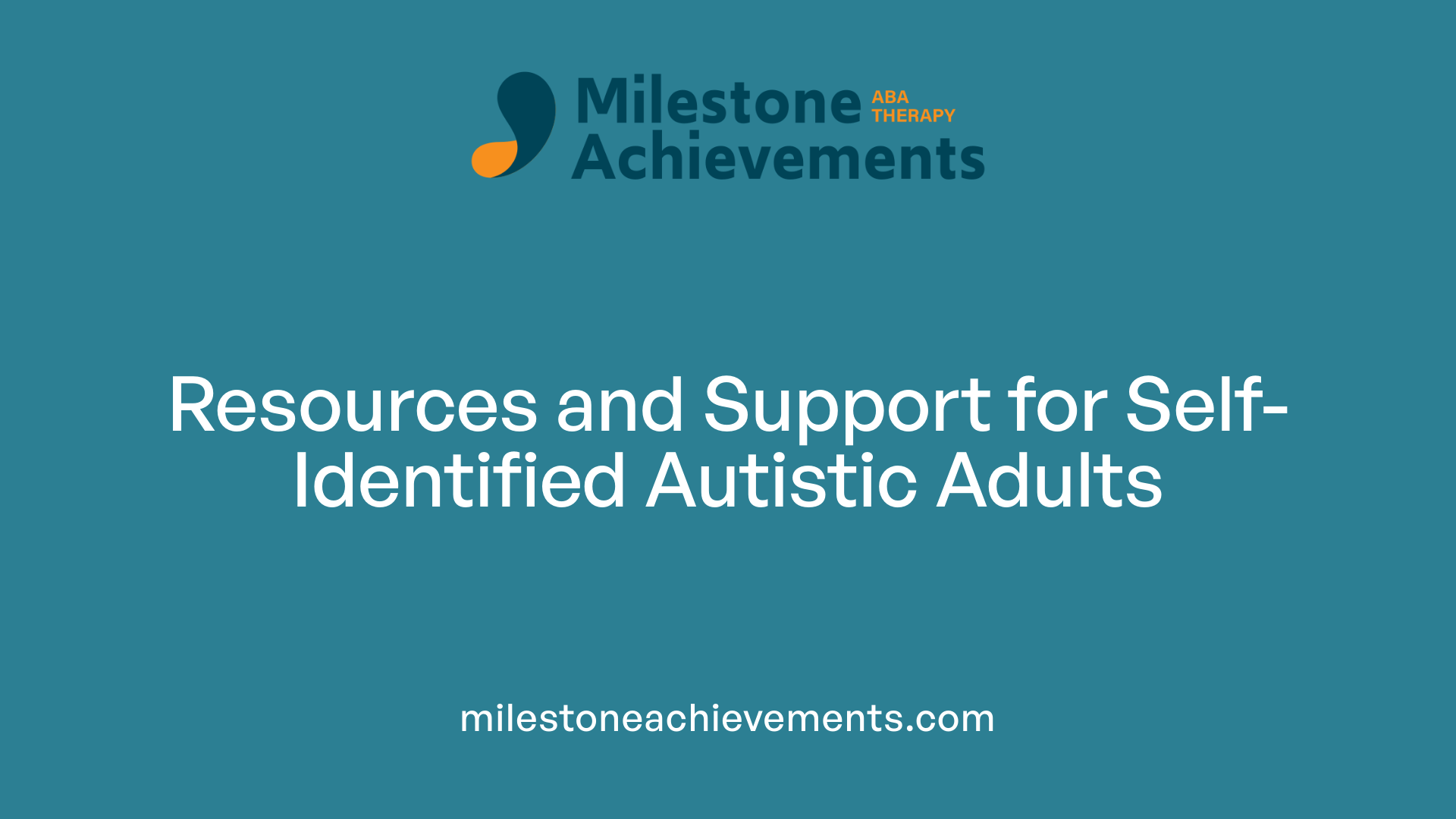
What resources are available for self-identified autistic individuals?
Self-identified autistic adults often find valuable support through various community organizations, online platforms, and advocacy groups. These resources are essential for gaining information, emotional support, and guidance on managing daily challenges.
Websites like Autism BC and other dedicated advocacy groups provide a wealth of information about autism, tailored to both diagnosed and self-identified individuals. They offer educational materials, peer support networks, and practical advice on navigating social, educational, and employment environments.
Support groups and online forums serve as safe spaces for individuals to share experiences, seek advice, and build community. Platforms such as social media groups enable connections across geographical boundaries, fostering a sense of belonging and understanding.
Can self-identified individuals access support and accommodations?
Many supports are accessible without a formal diagnosis. Community-based programs, online resources, and peer-led groups often welcome all self-identified autistic adults. These supports include social groups, employment accommodations, and educational assistance, which do not necessarily require official certification.
However, some services, particularly those related to healthcare, legal protections, and certain specialized support programs, may require a formal diagnosis. Accessing these services can be challenging for those who are self-identified, especially if eligibility hinges on official medical certification.
Despite this, the growing recognition of self-diagnosis validity means that many organizations are increasingly accommodating individuals based on their self-reported needs and experiences.
Why is it important to seek a professional diagnosis despite self-identification?
Obtaining a formal diagnosis from qualified healthcare professionals such as psychologists or psychiatrists provides several benefits. It offers official validation of autism, which can be crucial for accessing specific legal protections and support services.
A professional assessment helps differentiate autism from other overlapping conditions like ADHD, anxiety, or depression, ensuring that individuals receive appropriate interventions.
Furthermore, a diagnosis can facilitate tailored healthcare, educational adjustments, and employment accommodations. It can also provide clarity for individuals and their families, fostering better understanding and acceptance.
While self-identification is meaningful, especially for those facing barriers to diagnosis, seeking a professional evaluation remains an important step for comprehensive support and recognition.
| Resource Type | Available To | Description | Additional Notes |
|---|---|---|---|
| Online Support Groups | Self-identified adults | Peer networks and forums for sharing experiences | Many are accessible without diagnosis |
| Advocacy Organizations | All individuals | Educational information and community support | Examples include Autism BC and others |
| Community Programs | Self-identified & diagnosed | Social skills, employment support | Some may require formal diagnosis |
| Healthcare Services | Diagnosed individuals | Clinical assessments, therapies | Diagnosis often needed for access |
| Educational Support | Students & adults | Accommodations in learning environments | Usually require official diagnosis |
Having resources easily available empowers self-identified autistic adults to navigate societal challenges, build community, and seek support tailored to their needs.
Additional Information for Self-Identified Autistic Adults
- Various online tests like the Autism Quotient (AQ) and RAADS–R can offer indicative insights but are not definitive.
- Community organizations often provide workshops, counseling, and peer mentorship.
- It’s crucial to validate personal experiences and seek professional advice when possible.
- The movement towards acceptance highlights the importance of respecting self-identification, while also advocating for improved diagnostic pathways for those who wish to pursue formal assessment.
By leveraging these resources, self-identified individuals can enhance their understanding of autism, access support, and foster self-acceptance, creating a more inclusive environment for all.
Conclusion: Navigating Autistic Identity and Support Pathways
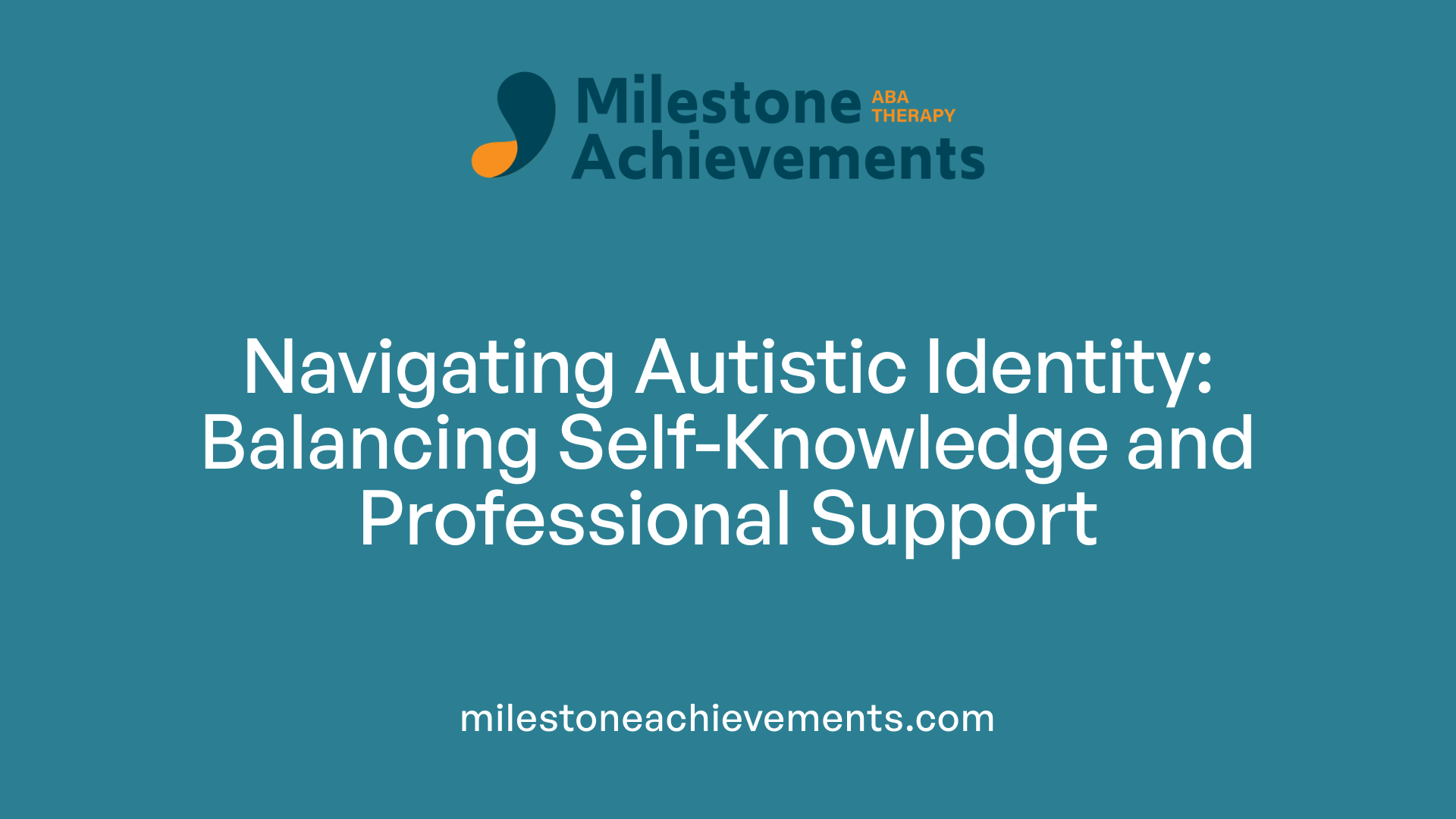
Why is it important to balance self-awareness and professional diagnosis?
Understanding oneself as autistic can be a profound and validating experience. For many, self-identification provides clarity, community connection, and emotional relief. It allows individuals to recognize their own traits, strengths, and challenges, fostering self-acceptance.
However, relying solely on self-diagnosis has limitations. A formal diagnosis by qualified health professionals offers authoritative validation, which can be crucial for accessing appropriate support, treatment, and legal protections. It also helps rule out other conditions with overlapping symptoms like anxiety, ADHD, or mood disorders.
Balancing these aspects means respecting personal insights while encouraging pathways to official assessment when feasible. This approach ensures that support systems align with accurate understanding, ultimately empowering individuals to navigate their lives with confidence and appropriate resources.
How can society better support self-identified autistic adults?
Society can play a vital role in embracing and supporting self-identified individuals. Recognizing self-diagnosis as a valid part of the neurodiversity movement can promote inclusivity and reduce feelings of marginalization.
To facilitate this, reducing systemic barriers is essential. This includes making autism assessments more accessible, affordable, and timely, especially for adults who face long waitlists, high costs, or geographic limitations.
Educational initiatives for healthcare providers can improve understanding of adult autism and the importance of respecting self-identification. Supporting peer-led communities and online support networks also helps foster a sense of belonging and empowerment.
By promoting inclusive policies and broadening perceptions of what constitutes a valid autism identity, society can create a more supportive environment for all individuals on the spectrum.
What does the future hold for autism diagnosis and community acceptance?
Emerging research increasingly supports the validity of self-diagnosis and highlights the importance of community acceptance. As awareness of neurodiversity grows, there is a shift toward recognizing that traditional diagnostic pathways do not capture all individuals who experience autism traits.
Innovation in diagnostic tools and assessment methods, including neurodivergent-friendly approaches, is underway. These future developments aim to make diagnosis more accessible, less invasive, and more reflective of individual experiences.
Community-led initiatives and advocacy groups are vital in fostering acceptance and reducing stigma. Greater societal acknowledgment of neurodiversity will likely lead to expanded inclusion policies, workplace accommodations, and legal protections.
As understanding deepens, the line between clinical diagnosis and self-identification may continue to blur, enriching the discourse around autism support and acceptance. This evolving landscape promises a future where diverse pathways to understanding and embracing neurodivergence are fully recognized and valued.
Supporting Autistic Identities in a Changing Landscape
As awareness and understanding of autism continue to evolve, the intersection of self-diagnosis and formal assessment reflects broader societal shifts towards inclusivity and respect for neurodiversity. While self-identification empowers many individuals and fosters community cohesion, professional diagnosis remains crucial for ensuring appropriate support, resource access, and legal recognition. Moving forward, improving pathways for assessment, validating self-recognition, and reducing systemic barriers will be vital in embracing diverse journeys towards understanding and acceptance of autism.
References
- Autism Self-Diagnosis: Can You Diagnose Yourself With Autism?
- Wondering if you're Autistic? | CHOP Research Institute
- As an Autistic Psychologist, Here Are My Thoughts on Autism and ...
- Structural Validation of the Autism Spectrum Identity Scale and ...
- Autism screening
- Deciding whether to seek an autism assessment
- Self-Diagnosed Autism: Is It a Valid Diagnosis?
- Is self-assessment enough? | Embrace Autism
- Exploring the Experience of Self-Diagnosis of Autism Spectrum ...
- Understanding the Self-identification of Autism in Adults: a Scoping ...







